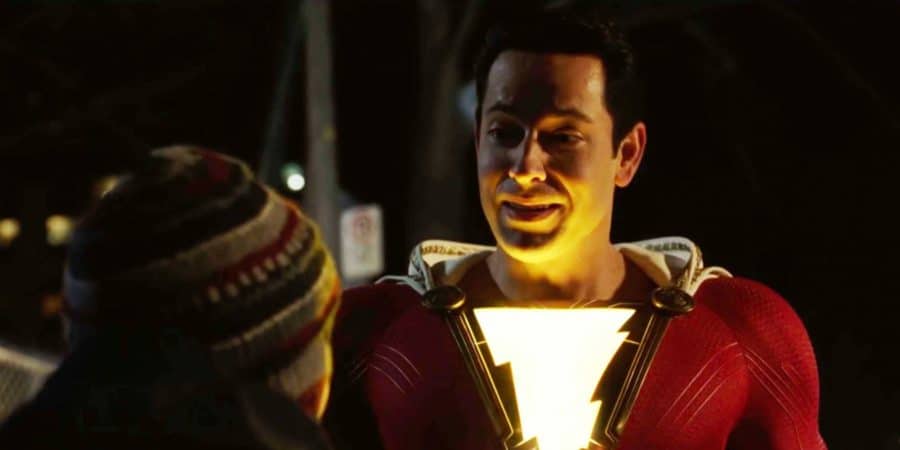SHAZAM! in 4DX
When I was discussing 4DX with a friend recently, he seemed frustrated by the concept.
“I’d rather see a movie than go to a theme park attraction,” he told me. “A really good movie would make me feel the wind and the shaking without actually doing that to me.”
Ironically, Shazam!, which I saw here tonight, harkens back to an era where 70mm six-track sound was as good as it got for a fully-loaded theatrical outing. Reactions have made parallels to Big (accurate) and Home Alone (only because they’re both set during Christmas), but this definitely has the vibe of something Spielberg or Amblin would have had their name attached to 35 years ago. It’s an old soul of a film, one that isn’t afraid to exclusively cater to a younger crowd with its free-spirited chaos and surprising but well-balanced tonal shifts, but we’ve come a long way since 1984.
Back in February, I got a look at Alita: Battle Angel at Hollywood’s 4DX Lab that disproved those reservations. At the time, one of 4DX owner CJ’s representatives, Sarah Edge, described the format as an immersive means of “making the audience feel like they’re really with [the characters]… thick and thin.”
On tonight’s return trip to see Shazam! at the 4DX Lab, Edge alerted attendees that the front row of the private, 16-seat theater had been outfitted with new seats. These seats, she said, had technology unavailable commercially in the United States, notably a temperature enhancement that creeps behind your neck.
Said enhancement came in handy during the film’s training sequence, where the title hero (Zachary Levi) learns he’s impervious to fire. Also new to the lab’s screening room: olfactory enhancements. However, I forgot to take my Xyzal. While I do not doubt the smell bonus to 4DX, I was unable to pick up on it.
Shazam is prime for 4DX
Shazam!, opening Friday, is a prime choice for the format. Seats act as a personal subwoofer as everything from a straightforward scene in a car to a mid-air showdown unfolds. Dry ice rises from underneath the screen. More so than Alita, the lightning effects—key to the plot and represented by eight strobe lights in the theater—are stunning, illuminating the entire room. 4DX absolutely lends itself to a superhero film. Thankfully, they were not cruel enough to simulate the bitter cold of the Christmas season in Philadelphia, like that time I saw The Revenant in a Jersey theater with broken heat.
Certainly, Warner Bros. and New Line have had faith in Shazam! since the trailers debuted last summer. For a superhero film, it’s an obvious match. After all, the last big superhero film, Captain Marvel, thanks to a lack of competition, got three full weeks in 4DX.
“The exhibitors always decide what they want to show,” Edge said. “It’s always what they feel the big blockbusters are.” However, just because a film has pre-release momentum doesn’t guarantee a run in 4DX.
Edge said that CJ is committed to being “ahead of the game” regarding 4DX releases. Three major factors play into a film getting a 4DX release—the studio, quality control, and the director’s approval. The latter is telling, especially as Edge had described Alita director Robert Rodriguez as a fan of the format two months ago.
Before the film, a sizzle reel of news segments and trailers played. Director James Gunn called 4DX “one of the best possible ways you can see” any movie, a revelation he had in 2014 when seeing his Guardians of the Galaxy at the tech-ready Regal L.A. LIVE theater in downtown Los Angeles. He was so impressed by the presentation that he asked to help supervise Guardians of the Galaxy Vol. 2’s 4DX unveiling.
One week is the standard rule of thumb for this kind of release, but it is all subject to the market, studios, and exhibitors. With the technology available in theaters in over 100 countries, Edge said that “a wide palate of choices” exist for international markets, who might not want, say, Pet Sematary, also opening this weekend in 4DX. They may want Hellboy, which carries a more recognizable IP overseas and opens in 4DX next week stateside. Some theaters might even want something offbeat.
“They showed The Disaster Artist in 4DX,” Edge recalls after Shazam! ended. Yes, you read right. James Franco’s stranger-than-fiction tale of Tommy Wiseau’s rise from whoever he exists as to the superstar of the cult classic The Room played in 4DX. Reportedly, Franco and other essential personnel reacted, as Edge mimics in the vein of Owen Wilson, “Wow… wow… wow.”
The possibilities are endless for 4DX. For Shazam!, the territory and potential are safe, for lack of a better word, but David Sandberg’s kitchen-sink treatment of the material forges an irresistible synergy. As for my friend, I think a 132-minute dark ride would be a sensory overdose—exactly why this technology’s nuances are so winning theatrically.


![Project Blue Book Season 1: Thrills Some Amuses Others [Review]](https://andersonvision.com/wp-content/uploads/2019/04/project-blue-book-header.jpg)
